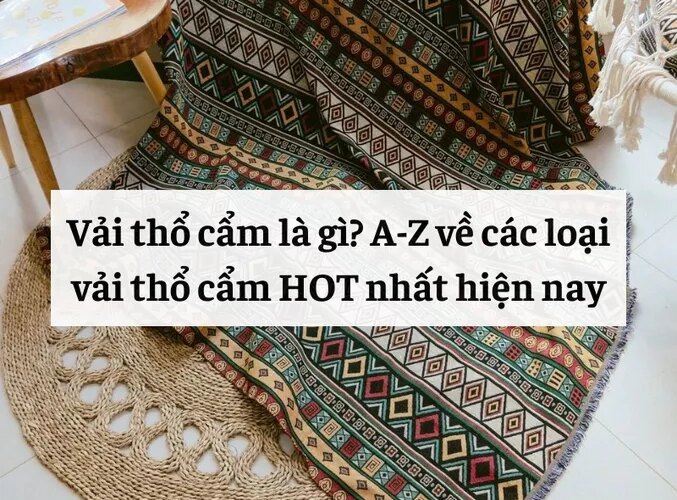We can’t forget the timeless tradition of Brocade fabric. It is still widely used in Vietnam, reflecting its national identity. Learn more about its origin and weaving process. Explore Fashion Bandung to find out more!
What is brocade fabric? Where does brocade fabric originate from?
Brocade fabric, in English, refers to a type of fabric that is meticulously hand-woven using cotton, flax, hemp fibers, and other materials. It holds significant cultural value in various ethnic minority regions and is considered a symbolic representation with distinct meanings. It is commonly utilized for sewing traditional costumes and fashion accessories. The fabric exhibits intricate details and patterns that resemble exquisite hand embroidery, but in reality, the entire production process is performed on a loom.
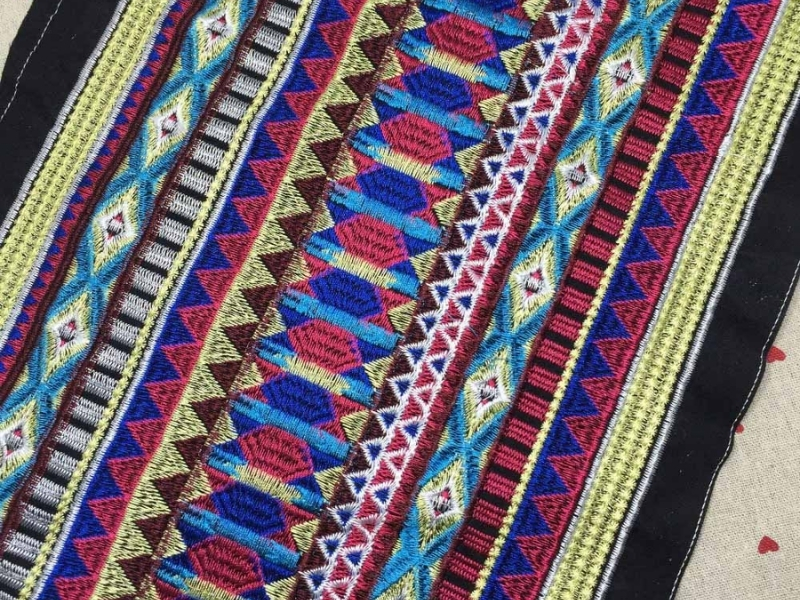
Brocade fabric is a luxurious type of fabric that is crafted by hand-weaving fibers, such as cotton, linen, hemp, and others. It is known for its intricate patterns and designs which are created by the weaving technique.
Ethnic brocade fabric is known for its vibrant array of colors, intricate patterns, and unique motifs. What sets this fabric apart is that its colors are completely natural, as it does not undergo any chemical dyeing processes. The hues of the fabric are derived solely from the colors found in flowers, making each piece truly unique and preserving the natural beauty of the material.
- Red: Made from boiled water of crushed Krung bark.
- Yellow: Derived from turmeric.
- Dark red: Usually taken from the bark of tree trunks.
- Black: Dye from calabash leaves soaked in young mud for a while.
- Reddish brown: Use from the bark of the alder tree, soak in vinegar water and boil.
- Green: Cook dry snail shells, soak in lime then soak with indigo leaves.
What is the process of brocade weaving?
Cotton processing involves several steps. After approximately 6 months of growth, cotton plants reach maturity and become suitable for harvesting. It is best to harvest the plants when they are in full bloom, typically on sunny days. Once harvested, the cotton undergoes a drying process to remove any moisture.
To prepare the cotton for further processing, a specific tool is employed to break open the cotton bolls, which are the protective capsules that contain the cotton fibers. This mechanical procedure ensures that the fibers become soft and fluffy.
After the bolls are broken, the raw cotton fibers are rolled to create a cohesive bond among them. This rolling process helps to align the fibers and prevent them from coming apart easily. This bonded form of raw cotton can then be utilized for various applications in the textile industry.
Spinning: After the cotton has been pre-processed, the next crucial step is to crumple the cotton sliver. This step is essential in the spinning process.
Brocade Weaving Process: During this process, the skilled artisans utilize a small stick or a 40cm long chopstick to tightly roll the cotton thread until it reaches the size of a big toe. Finally, they use their hands to pull these bundles of thread, resulting in a fabric thread approximately 15cm long.

The process of weaving brocade involves five distinct steps.
Fabric treatment: After the yarn has been drawn, it undergoes a process where it is divided into two parts and soaked in a porridge water solution. One part of the yarn is dyed before it is woven, while the other part is dyed after weaving. In the case of threads that are used to create distinctive patterns or details, they are separated and then dyed. The choice of dyeing materials depends on the desired outcome, with natural materials such as leaves, tree trunks, flowers, and other plant-based sources being used to create various colors for the fabric.
At this stage, the weavers carefully spread the fabric and use large combs to smooth it out, ensuring that it doesn’t become tangled. This step requires highly skilled individuals who are well-versed in this complicated process. Once the fabric is finished, they proceed with the intricate knitting, threading, or flower insertion process, which involves creating various patterns and designs.
The brocade fabric produced from this meticulous craftsmanship is known for its unique patterns and the inclusion of many beautiful motifs.
Dyeing cloth is a meticulous process that involves several steps. It begins with the craftsman setting up the loom and carefully inspecting it to ensure everything is in place. Since the weaving is done by hand, the craftsman must remember each thread and pattern in order to replace the colored thread spools correctly.
Any mistakes or forgetfulness during the weaving process are promptly identified and corrected at the relevant location. This attention to detail is crucial to ensure that the final product meets the desired standards.
Once the weaving is completed, the next step is dyeing the woven fabric. This is where the true artistry comes into play. The craftsman skillfully selects the colors and dyes to create a unique and distinctive ethnic brocade fabric. This step is carried out with precision and care to ensure that the colors penetrate the fabric evenly and result in a visually appealing final product. Overall, the entire process of dyeing cloth requires a skilled craftsman who pays attention to every detail to produce high-quality, beautifully dyed ethnic brocade fabric.
Pros and cons of ethnic brocade fabrics.
One of the benefits of this is that it provides an advantage.
- The fabric is made from natural materials so it is extremely soft, comfortable and extremely cool.
- Has good sweat absorption.
- Many colors and diverse patterns, making it easy for you to choose.
- No colorants used so it is extremely safe for the skin.
- Environmental friendliness.
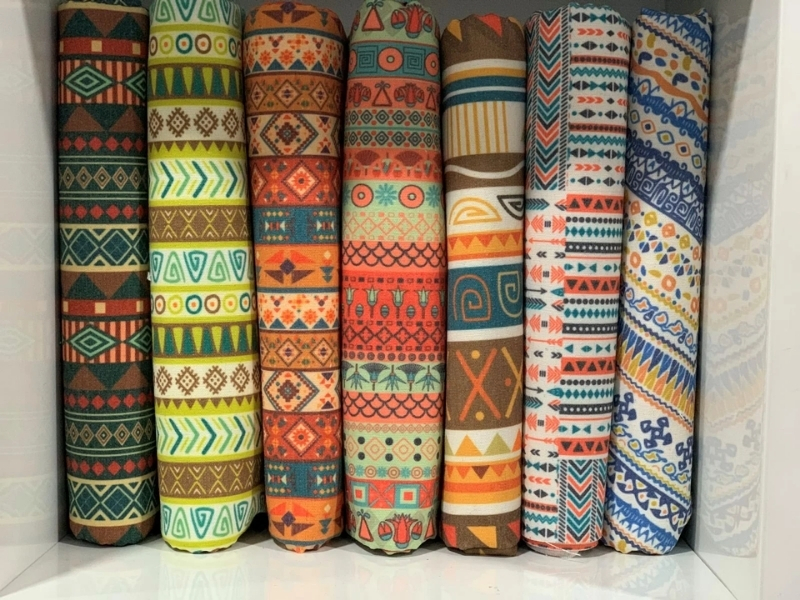
Advantages and disadvantages of ethnic brocade fabrics can be examined in detail. Ethnic brocade fabrics offer several benefits. Firstly, they exhibit intricate and exquisite designs, often incorporating vibrant colors and elaborate patterns. This makes them visually appealing and adds a touch of luxury and elegance to any garment or textile they are used for. In addition, ethnic brocade fabrics are known for their durability and long-lasting nature. They are woven with precision and high-quality materials, ensuring that they can withstand the test of time and frequent use.
Furthermore, ethnic brocade fabrics have cultural significance and are deeply rooted in tradition. They often represent the heritage and craftsmanship of a particular ethnic group or region, making them valuable from a cultural and historical perspective. This makes them a popular choice for individuals who want to celebrate and preserve their ethnic identity.
However, there are also certain drawbacks associated with ethnic brocade fabrics. Firstly, due to their intricate designs and high-quality materials, they tend to be more expensive compared to other types of fabrics. This can limit accessibility for individuals with a tight budget. Additionally, the elaborate patterns and heavy weight of brocade fabrics can make them less suitable for everyday wear or casual occasions. They are often reserved for special events or formal attire.
Another disadvantage is that brocade fabrics may require special care and maintenance. Their delicate nature necessitates careful handling, dry cleaning, or gentle hand washing, which can be time-consuming and inconvenient for some individuals.
In summary, ethnic brocade fabrics offer numerous advantages such as their visually appealing designs, durability, and cultural significance. However, their higher cost, limited suitability for casual wear, and special care requirements can be considered as potential disadvantages.
Defect:
An issue or flaw that is present in a product, system, or process. It refers to any deviation from the expected or desired functionality or quality standards. Defects can cause failures, errors, or malfunctions in the product, leading to dissatisfaction among users or customers. They may arise due to design flaws, manufacturing errors, coding mistakes, or other factors that impact the performance or usability of the product. Defects need to be identified, analyzed, and rectified to ensure that the product meets the intended requirements and delivers the expected level of performance.
- Brocade fabric need to wash carefully, difficult to preserve.
- Easily torn if rubbed too hard.
- Because of its natural color, it is very easy to fade.
- Less commonly used to create everyday clothing such as men T – shirt, trouser,…
Brocade fabric is widely used in modern life for various applications.
4.1. In the garment industry
Brocade fabric is extensively utilized in the garment industry for crafting traditional costumes of ethnic communities. Its popularity lies in its ability to bring forth unparalleled uniqueness and creativity, while also paying homage to the traditional beauty of Vietnam. The clothing models fashioned from this fabric are widely adored due to their comfortable fit, non-restrictive nature, and excellent sweat absorption properties.
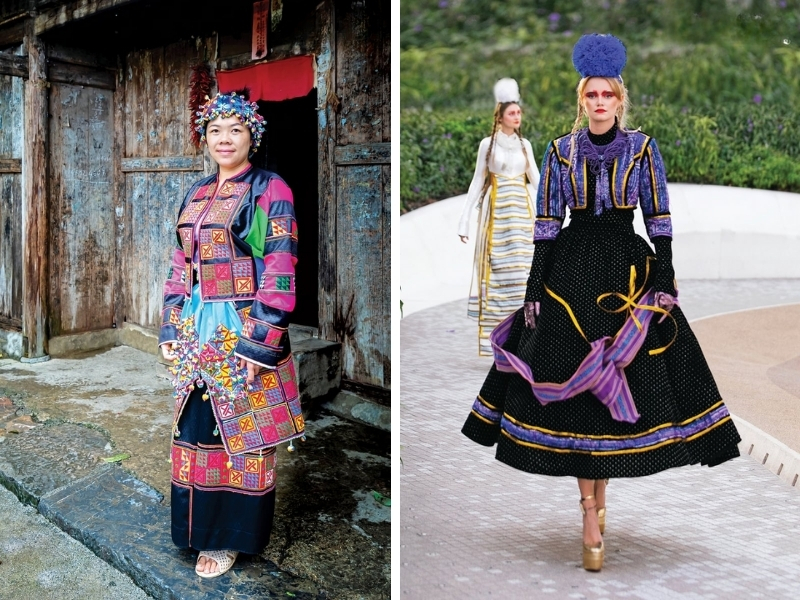
Brocade fabric is widely used in the garment industry for various applications due to its unique characteristics and aesthetic appeal.
One of the primary uses of brocade fabric is for creating luxurious and ornate garments. The fabric’s intricate patterns and raised motifs make it ideal for designing formal wear, such as evening gowns, wedding dresses, and cocktail dresses. The shimmering effect created by the metallic threads woven into the fabric adds a touch of elegance and sophistication to these garments.
Furthermore, brocade fabric is often utilized in the production of traditional and cultural clothing. Many traditional dresses, such as the kimono in Japan or the cheongsam in China, feature brocade fabric to showcase the rich cultural heritage and craftsmanship. The fabric’s intricate designs and vibrant colors play a significant role in capturing the essence of these traditional garments.
In addition to its use in garments, brocade fabric is also favored in the creation of accessories. It is commonly used to make handbags, purses, and shoes, as well as in the production of home decor items like curtains, tablecloths, and pillow covers. The luxurious appearance of brocade fabric adds a touch of opulence and grandeur to these accessories, making them highly desirable.
Another application of brocade fabric in the garment industry is in costume design. The fabric’s ability to replicate historical patterns and designs makes it the perfect choice for creating period costumes for film, theater, and reenactments. The fabric not only helps in recreating the authenticity of the era but also provides durability and structure to withstand the rigors of performances.
Overall, the applications of brocade fabric in the garment industry are diverse and versatile. Its unique patterns, shimmering effect, and rich cultural connotations make it a popular choice for creating luxurious garments, traditional clothing, accessories, and costumes.
Additionally, brocade fabric is crafted using natural plants and flowers as raw materials, making it exceptionally safe for the skin and environmentally friendly. However, due to its more formal and intricate nature, brocade fabric is seldom utilized in everyday clothing such as men’s pants, T-shirts, shirts, and other casual attire.
4.2 In interior design
In addition to its applications in the garment industry, ethnic brocade fabric is also widely used in interior design and decoration. This versatile fabric can be found in various home furnishings such as cushions and sofa covers, adding a touch of freshness and serving as a focal point in the homeowner’s space. Furthermore, brocade fabric is often used in the creation of tablecloths, curtains, and other interior items, showcasing its flexibility and adaptability in enhancing the overall aesthetics of a room.
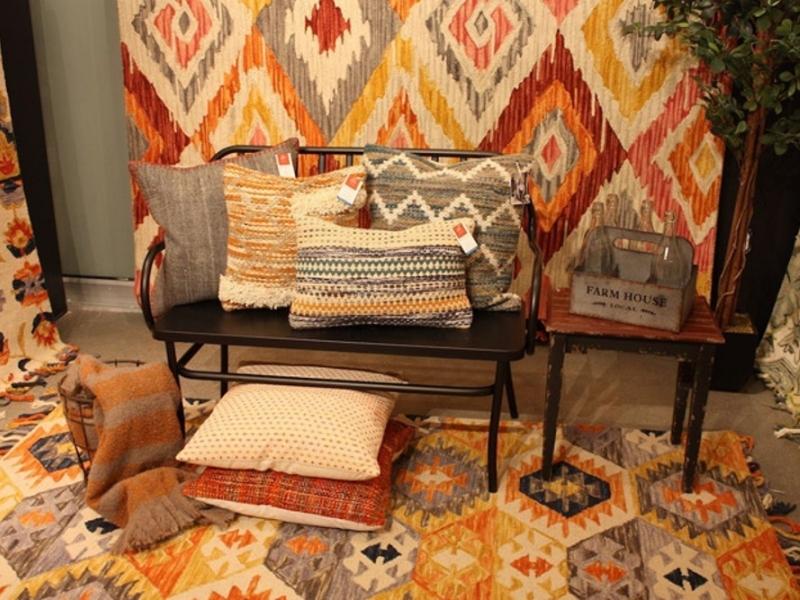
Brocade fabric is a versatile textile that finds numerous applications in the field of interior design. This exquisite fabric, known for its intricate patterns and luxurious appearance, adds a touch of elegance and sophistication to any space it is incorporated into. From draperies and upholstery to pillows and wall hangings, brocade fabric can be used in a variety of ways to enhance the aesthetic appeal of a room.
One popular application of brocade fabric in interior design is for curtains and drapes. The rich texture and intricate designs of brocade fabric make it an excellent choice for window treatments, creating a luxurious and opulent look. Whether used as full-length curtains or as elegant drapery accents, brocade fabric adds a sense of grandeur to any window.
In addition to window treatments, brocade fabric is often used for upholstery. Chairs, sofas, and ottomans covered in brocade fabric instantly become statement pieces, catching the eye and elevating the overall design of a room. The durability and strength of brocade fabric make it suitable for furniture upholstery, ensuring that it will withstand the test of time while maintaining its luxurious appearance.
Another way to incorporate brocade fabric into interior design is through decorative accessories such as pillows and cushions. These small accents can make a big impact, adding a touch of luxury and refinement to a space. Brocade fabric pillows, embellished with intricate patterns and often adorned with tassels or fringes, bring a sense of elegance and glamour to sofas, chairs, or beds.
Brocade fabric can also be used as a statement wall covering or tapestry. When hung on a wall, it creates a focal point and adds depth and texture to the room. The shimmering threads and intricate designs of brocade fabric make it a captivating choice for showcasing a piece of art or creating a stunning backdrop.
In conclusion, brocade fabric is a versatile material that has numerous applications in interior design. Whether used for curtains, upholstery, pillows, or wall hangings, the intricate patterns and luxurious appeal of brocade fabric elevate the aesthetic of any space. Its versatility, durability, and ability to add a touch of elegance and sophistication make it a popular choice among interior designers.
4.3. In bedding production
Many individuals have utilized brocade fabric for making bedding. This particular fabric adds a distinctive highlight to bedrooms. Brocade fabric is known for its inherent colorfulness, so it is typically used in small portions for decorative purposes, ensuring overall harmony in the bedroom. If the entire bedding is made from brocade fabric, it can appear overly flashy and confusing. Therefore, using brocade fabric sparingly for decorative accents is the preferred approach.

Brocade fabric, with its intricate designs and luxurious texture, finds various applications in the production of bedding. This exquisite fabric is popularly used in making pillowcases, bedspreads, comforters, and duvet covers. The rich and elegant appearance of brocade adds a touch of opulence to any bedroom decor.
In pillowcase production, brocade fabric is favored for its durability and smoothness. It is often used to create decorative pillowcases that enhance the aesthetic appeal of the bedding ensemble. The intricate patterns and vibrant colors of brocade can instantly elevate the overall look and feel of a bedroom.
Bedspreads made from brocade fabric are sought after for their luxurious look and feel. The fabric’s richness and sheen give the bedspread an extravagant touch, making it a focal point in the bedroom. Brocade bedspreads are available in various designs, from classic and traditional to modern and contemporary, making them suitable for different interior styles.
Comforters filled with soft padding and covered with brocade fabric provide both warmth and elegance to the bedding. Brocade’s intricate motifs and designs add depth and sophistication to the comforters, making them a perfect addition to upscale bedrooms. The fabric’s durability ensures that the comforter retains its beauty even after multiple washes.
Duvet covers made from brocade fabric can transform a plain duvet into a stunning piece of bedding. The fabric’s intricate weave and shimmering threads create a visually appealing cover that enhances the overall appeal of the bedroom. Brocade duvet covers are available in a range of colors and patterns, allowing homeowners to find the perfect match for their bedroom decor.
In conclusion, the applications of brocade fabric in bedding production are diverse and versatile. Its luxurious appearance, durability, and wide range of designs make it a popular choice for pillowcases, bedspreads, comforters, and duvet covers. Brocade fabric adds an element of elegance and sophistication to any bedroom decor, making it a preferred material in the world of bedding production.
4.4. When making accessories
Brocade fabric is widely used in the production of various accessories, ranging from small to complex items. Many young people are drawn to items made from this fabric because they offer a new and unique look, while also making the overall appearance more prominent. When traveling in mountainous areas, you can find souvenir stalls that sell accessories made from brocade, such as scarves, handbags, wallets, hats, and men’s belts. These accessories add an extra touch of style and elegance to any outfit.
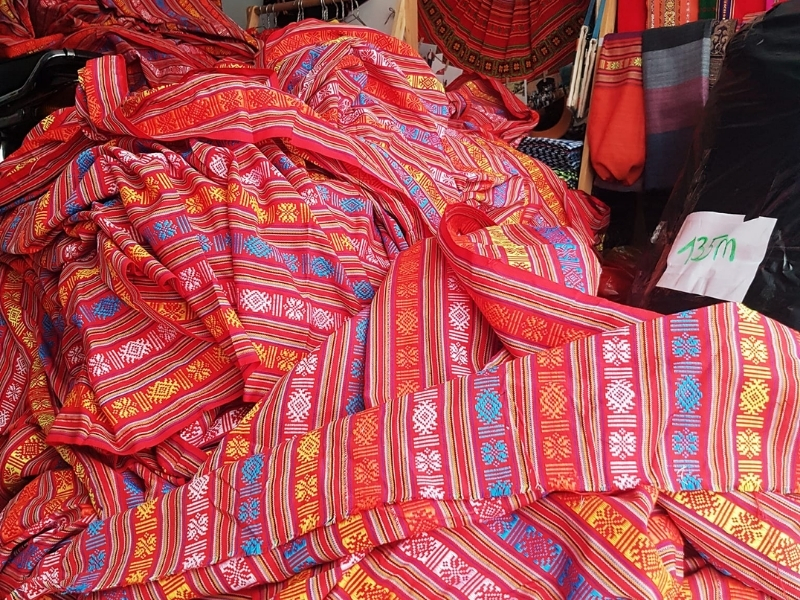
The versatile brocade fabric finds extensive applications in the manufacturing of various accessories. Whether it’s handbags, wallets, belts, shoes, or even hair accessories, brocade fabric adds a touch of elegance and sophistication to these items. The intricate patterns and designs created on the brocade fabric make it a popular choice for those wanting to make a fashion statement. Its durability and luxurious feel also make it suitable for high-end accessories. Brocade fabric is not only aesthetically pleasing but also provides functionality, as it can withstand regular use and maintain its appearance over time. The wide range of colors and textures available in brocade fabric further enhances its versatility, allowing designers to create unique and eye-catching accessories for different occasions and preferences. With its rich history and timeless appeal, brocade fabric continues to be a sought-after material in the accessory manufacturing industry.
What is the most effective method for conserving brocade fabric?
Brocade fabric is known for its stunning beauty, but it requires special care to preserve its colors and quality. Unlike other fabrics, brocade is woven and dyed using natural fibers. This means that it needs to be preserved more meticulously and carefully to avoid fading quickly during use. To ensure the longevity of your brocade fabric, it is important to follow these principles:
1. Avoid direct sunlight: Exposing brocade fabric to direct sunlight can cause its colors to fade quickly. It is best to keep brocade items away from windows or use curtains to block out sunlight.
2. Gentle washing: When cleaning brocade fabric, it is important to use a gentle washing method. Hand washing is recommended using mild detergent and lukewarm water. Avoid harsh scrubbing or twisting the fabric, as it can damage the delicate weaving.
3. Test for colorfastness: Before washing your brocade item, it is best to test for colorfastness. Dampen a small inconspicuous area of the fabric and gently blot with a white cloth. If no color transfers, it is safe to proceed with washing.
4. Use cold water for rinsing: After washing, rinse brocade fabric with cold water to remove any remaining detergent. Cold water helps to preserve the color and prevent any shrinkage.
5. Air-dry or low heat drying: Avoid using high heat or direct sunlight to dry brocade fabric. Instead, gently squeeze out excess water and lay it flat on a clean, dry towel. Let it air-dry naturally or use a low heat setting on your dryer.
6. Store with care: When storing brocade items, it is advisable to use acid-free tissue paper to protect the fabric. Avoid folding or crushing the fabric to prevent creasing. Store in a cool, dry place away from direct sunlight and moisture.
By following these principles, you can ensure that your brocade fabric remains vibrant and beautiful for years to come.
- Never use strong detergents: This will cause the fabric to fade easily, losing the beauty of the outfit. In addition, if used for a long time, the fabric can also become thinner, causing the quality to decrease.
- Hand washing is preferred: Because the weaving process is done by hand, using a washing machine will break the fabric structure, causing the outfit to stretch or tear. Therefore, to ensure the fabric is always durable and beautiful, you should wash your outfit by hand.
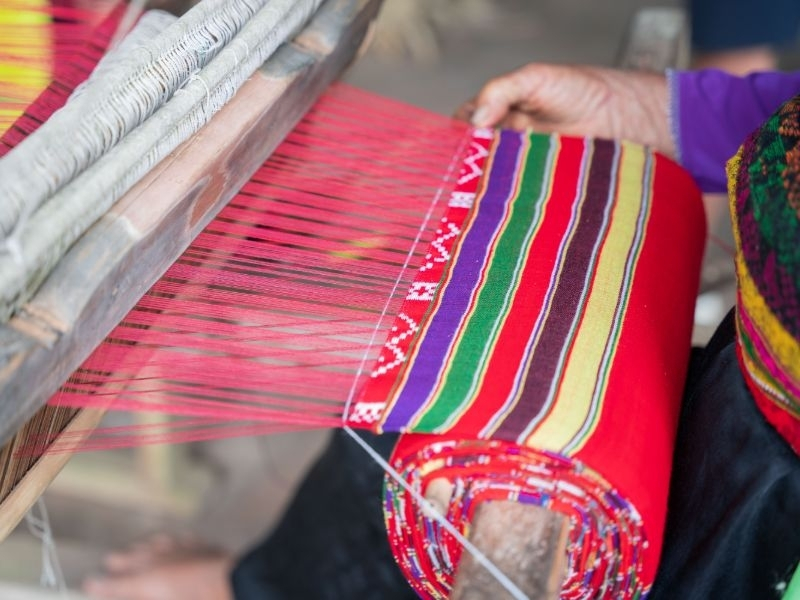
One of the best ways to ensure the longevity and beauty of brocade fabric is by following proper preservation techniques. By taking care of this delicate fabric, you can keep it looking as durable and stunning as the day you first acquired it.
Firstly, when storing brocade fabric, it is important to keep it in a clean and dry environment. Moisture can promote the growth of mold and mildew, which can irreversibly damage the fabric. Therefore, it is advisable to store brocade in a cool and dry place, away from any potential sources of moisture.
Additionally, to prevent any potential staining or discoloration, it is vital to keep brocade fabric away from direct sunlight. Prolonged exposure to sunlight can cause the colors to fade and the fabric to weaken. If possible, store brocade in a dark or low light area.
Furthermore, when handling brocade fabric, clean hands or using white cotton gloves is recommended. Oils, dirt, and other residues on the hands can transfer onto the fabric and cause staining or damage over time. By using gloves or ensuring clean hands, you can minimize the risk of transferring unwanted substances onto the fabric.
When it comes to cleaning brocade fabric, it is advisable to follow the specific care instructions provided by the manufacturer, as different brocade fabrics may have different cleaning requirements. In general, dry cleaning is usually the safest option. However, if handwashing is necessary, a gentle detergent and lukewarm water should be used. Avoid wringing or twisting the fabric, as this can lead to stretching or distortion. Instead, gently squeeze out excess water and allow the fabric to air dry in a flat position.
Moreover, it is crucial to avoid using any harsh chemicals, bleach, or strong detergents when cleaning brocade fabric, as these can cause irreversible damage. Always test any cleaning products on a small, inconspicuous area of the fabric before applying them to the entire piece.
Lastly, regular inspection of brocade fabric is essential. Look for any signs of wear and tear, loose threads, or areas of weakness. Detecting these issues early on can prevent further damage and allow for timely repairs.
By implementing these preservation techniques, you can ensure that your brocade fabric remains durable and beautiful for years to come.
- Avoid soaking items in water for too long: It is best to soak brocade items in water for no more than 15 minutes before washing because soaking for too long will cause the fabric to fade easily.
- Do not expose to sunlight: Sunlight contains UV rays, which are extremely bad for brocade. You should only dry clothes in cool places, away from strong sunlight to protect the durability of the fabric.
Frequently asked questions about brocade fabric are answered here.
Is brocade fabric considered to be expensive compared to other types of fabric?
Due to the fact that Brocade fabric is entirely handwoven, its price is relatively high. Nevertheless, as the common saying goes, “you get what you pay for,” the undeniable quality of this fabric is worth the investment and is sure to exceed your expectations.
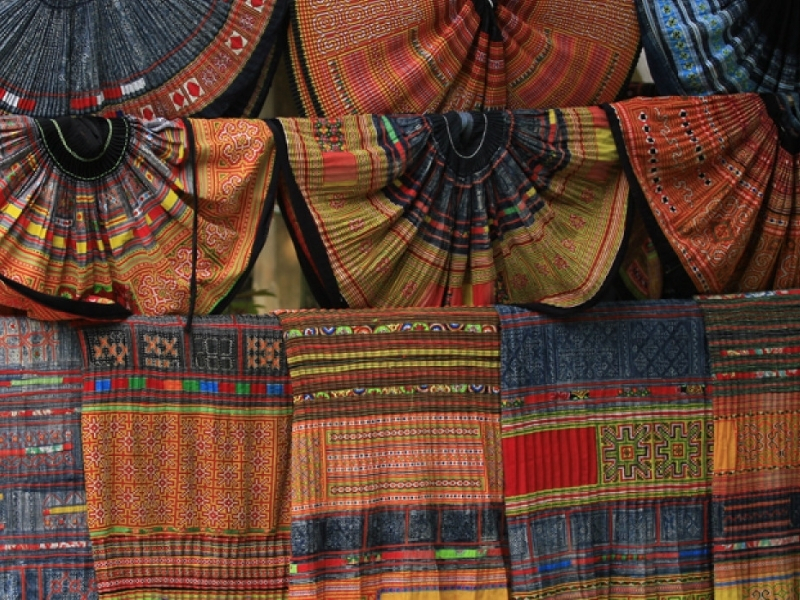
Here are some commonly asked questions about brocade fabric:
1. What is brocade fabric?
Brocade fabric is a richly decorative and woven fabric that features raised patterns or designs. It is usually made with silk or other luxurious materials and often incorporates metallic threads for added glamour.
2. How is brocade fabric made?
Brocade fabric is typically made using a special weaving technique called brocading. This involves weaving the base fabric with additional threads to create the raised patterns or designs. These additional threads are woven in a way that they float on top of the fabric, giving it a three-dimensional texture.
3. What are the characteristics of brocade fabric?
Brocade fabric is known for its sumptuous appearance and intricate designs. It has a luxurious feel and is often associated with elegance and sophistication. Other characteristics may include durability, subtle shimmer from metallic threads, and a slightly stiff drape.
4. What are the common uses of brocade fabric?
Brocade fabric is commonly used in high-end fashion and couture. It is often seen in evening gowns, wedding dresses, formal suits, and traditional garments such as saris and kimono. Home decor items such as curtains, upholstery, and throw pillows may also feature brocade fabric.
5. How should brocade fabric be cared for?
The care instructions for brocade fabric may vary depending on the specific materials used. In general, it is recommended to dry clean brocade fabric to preserve its quality and intricate details. However, some brocade fabrics may be machine-washable on a delicate cycle. It is always best to check the care label or consult a professional cleaner for specific care instructions.
6. Can brocade fabric be altered or modified?
Yes, brocade fabric can be altered or modified to suit individual preferences or design needs. Skilled tailors or seamstresses can make alterations such as hemming, taking in or letting out seams, or adding embellishments to enhance the overall look of the fabric.
7. Is brocade fabric suitable for all seasons?
Brocade fabric is often associated with formal occasions and colder seasons due to its heavier weight and luxurious feel. However, there are lightweight brocade fabrics available that can be suitable for warmer weather as well. It ultimately depends on the specific fabric and its composition.
Can you please provide the current price for brocade fabric per meter?
The price of 1 meter of brocade fabric can vary depending on the method used for fabric processing and the complexity of the patterns. Various factors can contribute to the differences in price.
- For patterned brocade fabric: Price ranges from 60 – 70 thousand VND/m2.
- For ethnic brocade fabrics: Price ranges from 160 – 180 thousand/m2.
Does wearing brocade fabric make you feel excessively warm and uncomfortable?
Brocade fabric is a type of fabric that is made from natural plant fibers such as flax and cotton. This fabric is known for its exceptional coolness and comfort when worn. It is highly breathable and allows air to circulate, keeping the wearer feeling fresh. Additionally, brocade fabric has excellent sweat absorption properties, preventing unpleasant stickiness or discomfort throughout the day.
Above, Fashion Bandung has provided you with information about brocade fabric. Brocade is a type of fabric that is highly regarded as a symbol of the ethnic minorities living in the mountains. This article aims to be helpful to readers by providing a better understanding of brocade and its various applications in daily life. Stay tuned to the Fashion Bandung News Page for more interesting knowledge updates. Don’t miss out!
Fashion Bandung is a clothing brand that specializes in providing fashionable clothing options for men. The brand offers a wide range of stylish apparel and accessories to cater to the diverse fashion preferences of men. From trendy outfits to classic ensembles, Fashion Bandung ensures that men can find the perfect clothing items to suit their personal style and make a fashion statement. With a focus on quality, comfort, and affordability, Fashion Bandung aims to provide men with the latest fashion trends and timeless wardrobe essentials. Whether it’s for casual wear, formal occasions, or any other event, Fashion Bandung is committed to offering men a wide variety of fashion-forward choices to enhance their individuality and confidence in every aspect of their lives.
For further information, please continue reading.

